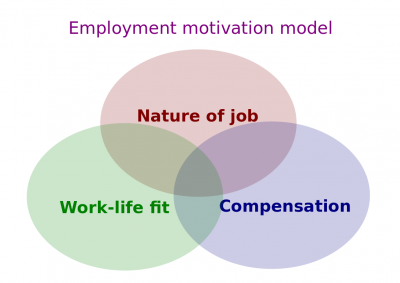What Employment Is
What Employment Is (hereinafter, the Lectio) is the first lesson part of the Employment Essentials lesson that introduces its participants to employment and related topics.
This lesson belongs to the Introduction to Employment session of EmployableU Concepts.
Content
The predecessor lectio is Options for the Graduates.
Script
- Employment is an agreement between at least two parties, one of which is an employer and another is an employee. The employer compensates the employee for his or her work time. The employee agrees to follow the employer's directions during work hours in exchange for the employee compensation. The employee compensation most commonly includes money called salary or wages. This agreement is called an employment agreement.
- An employer usually hires an employee to deliver some increments that the employer sells to the customers. Routinely, the employer collects money from the customers and pays the employees for the delivered work.
- The Work Motivation Model demonstrates what motivates people to be hired. In order to work, an employee needs to be comfortable with three things. The first is the nature of job itself, the second is the job's compensation, and the third is so-called work-life fit or job's fit to employee's life.
- How does it work? The writer of this very text wrote these very words because this person (a) liked writing, (b) was satisfied with the amount of money paid for this job, and (c) wrote these lines from home when it was convenient. The writer surely liked the job itself. Writer's compensation paid the bills and the leftover was good enough. That was the best case scenario; however, the ideal combination of all the three rarely happens. That is why people change their jobs. And, to help those people, CNMCyber Team develops CNMCyber.
Key terms
Closing
- Are you actively looking for a job? --Yes/No/Let's move on for now
Work Sellers is the successor lectio.
Questions
Placement entrance exam
- Every statement below is split into one true and one false question in the actual exam.
- "Employment" questions:
- (Not) every employment is paid.
- Both employee and employer (do not) necessarily enter into an employment agreement.
- Employment agreements, when are made, should (not) necessarily be written.
- Employment agreements, when are made, should (not) necessarily be oral.
- An employer can (not) stop paying an employee without an employee consent.
- "Employee" questions:
- An employer can modify what the employee should accomplish without the employee's consent.
- An employer can modify how the employee should accomplish his or her work without the employee's consent.

